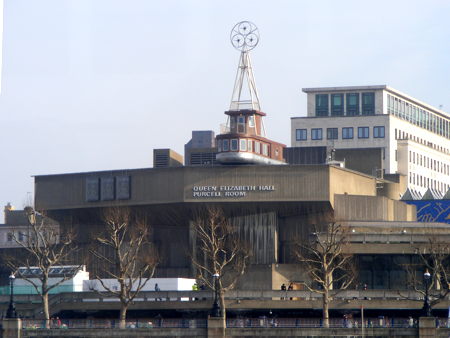Balancing conservation and commercialism on the South Bank
Architects, arts programmers and conservationists met on Friday to debate how the competing considerations of commercialism and conservation can be reconciled in the refurbishment of the Queen Elizabeth Hall and Hayward Gallery on the South Bank.

Friday morning's debate at New London Architecture was held as architects Feilden Clegg Bradley prepare to unveil their proposals for the £43 million expansion and refurbishment of the existing 1960s buildings.
Early documents lodged with Lambeth Council reveal that an 'infill extension' is proposed between the Hayward Gallery and the Queen Elizabeth Hall rising to nearly 45 metres, the same height as City Hall.
A 31-metre-high 'linear building' could sit between Waterloo Bridge and the Queen Elizabeth Hall.
The plans are likely to see venue and gallery space almost trebled to 9,000 sq m, with foyer space doubling to 3,000 sq m.
One of the most controversial elements of the new scheme is the 5,500 sq m allocated to restaurants and cafes.
Clare Hughes – creative producer at Feilden Clegg Bradley – argued that conservation and commercial considerations were indivisible and did not have to be in conflict.
"At Southbank Centre they've made an amazing job working with difficult buildings which were designed at a time when their artistic and cultural programme was structured around discrete, almost bunker-like, places for specific types of art," she said.
"Now the art is much more free-flowing and public space and free events are far more important than anyone could have imagined in the 1960s.
"With these buildings, their strengths are their weakness. I would say that their difficulty was part of their rationale: they were the rebellious teenager alongside the upper middle class parents at the Festival Hall."
She added: "Like most teenagers, they do have to start to grow up now. I think it's that growing process that we are trying to help with."
She continued: "Commerce is not a dirty word ... the Greek agora was a big open space that was for everything from sport to political speeches and trading.
"The Greek words for 'I shop' and 'I speak in public' are almost the same and they are both based on agora."
She concluded: "I feel we are helping Southbank Centre to get that balance right between 'I shop' and 'I speak in public'."
Catherine Croft, director of the 20th Century Society, took issue with Hughes' teenager analogy: "I kind of hope it doesn't have to grow up. The one thing I wouldn't want to see happen would be something major or permanent that cramped its style from being that place of fun and variety."
Graham Morrison, whose Allies and Morrison firm led the restoration of the Royal Festival Hall but lost out in the competition to work on the QEH and Hayward, explained how they had set about clearing out the retail from the floyer spaces inside the RFH, instead creating new outward-looking shops along Festival Riverside and Festival Terrace.
"Far from corrupting the arts institution as had been feared, it did the opposite," he said.
He recalled that although the original brief for the refurbishment was focussed on the interior of the Royal Festival Hall, the finished scheme won an award for best new public space.
"The inclusion of retail spaces ... has not only brought essential additional income to the centre, it has helped recover the building's original qualities."
Southbank Centre artistic director Jude Kelly said that the neglect of the Hayward and QEH buildings in past decades had created a "deplorable vacuum".
She highlighted initiatives such as A Room for London, the rooftop garden and the Festival Village which had sought to make better use of the building's spaces before a full-scale revamp.
Kelly stressed the role of culture as a tool for peacemaking: "One of the key things about curating 21 acres is how do you make sure that the whole landscape speaks to this?
"That it isn't then a series of buildings to which people rush to buy a ticket, but actually is a unique space beside the river where people can gather and find their way in to cultural expression?"
Comments
Share
The SE1 website is supported by people like you
More to read
- Mark Ball named as Southbank Centre artistic director 25 Aug 2021
- Southbank Centre warns of redundancies and potential £5m loss 25 May 2020
- Culture sec grants QEH and Hayward Gallery immunity from listing 10 Feb 2020
- Southbank Centre creative boss Madani Younis leaves after a year 23 Oct 2019
- Jail for man who threatened to stab skaters on South Bank 12 Nov 2018
- Madani Younis appointed as Southbank Centre creative director 5 Sep 2018
- Harry and Meghan visit South Bank for Mandela exhibition 17 Jul 2018
- Sadiq awards £700k to South Bank undercroft project 7 Mar 2018
- Jude Kelly to leave Southbank Centre 18 Jan 2018
- Crowdfunding appeal launched for South Bank undercroft upgrade 20 Jun 2017
Follow us
Email newsletter
For the latest local news and events direct to your inbox every Monday, you need our weekly email newsletter SE1 Direct.

